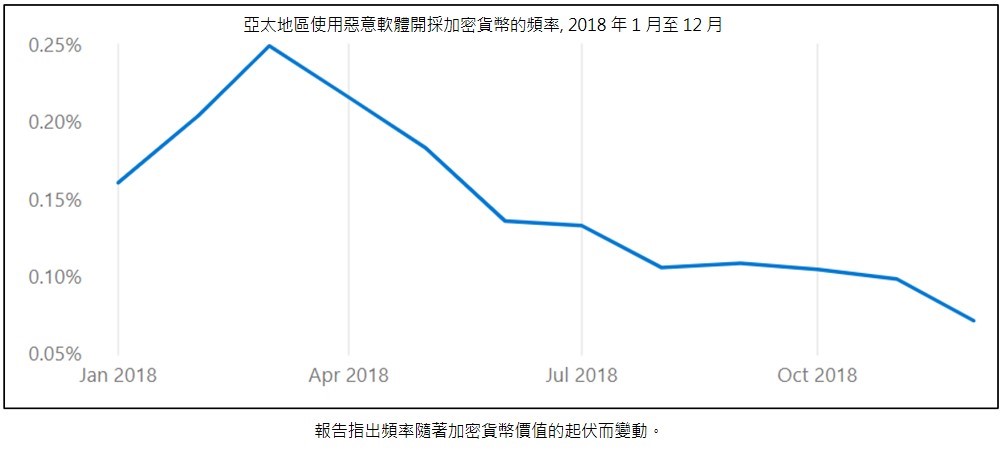犯罪份子利用漏洞開採加密貨幣、竊取資源
惡意軟體、勒索軟體、偷渡式下載,亞太地區增幅高於全球平均
| → 勒索軟體攻擊在全球呈現下降,但亞太地區遭受的勒索攻擊卻增加了40%。
→ 網路衛生習慣與安全意識不佳,亞太地區偷渡式下載與惡意軟體攻擊分別高於全球平均22%和37% > Internet hygiene habits and security perceptions are poor, and smuggling downloads and malicious software attacks in the Asia-Pacific region are different from the global average of > > > strong > 22% > >/em > > > strong and > > 37% /strang > > >. → 微軟建議:掌握預防、偵測、回應三要素,運用預防性控制、雲端和AI技術提升復原力,減少風險 |
(2019年 4月1日,台北訊)即使企業利用最新的安全情報和保護措施,在不斷變化的網路安全環境中努力立足,對網路犯罪份子而言,亞太地區依然是犯罪熱點。微軟在最新出爐的《智慧資安報告》(SIR),揭露亞太區的重點觀察,希望藉此提升亞太地區的網路攻擊防禦能力。
() 「毫無疑問地,網路安全是當今各企業組織最迫切的問題之一。隨著網路攻擊的頻率和複雜性不斷增加, 瞭解普遍存在的網路威脅以及如何降低其影響已成為當務之急。」微軟亞洲網路安全首席顧問Eric Lam 表示:「因應不斷進化的網路威脅環境,微軟在第24期的《智慧資安報告》中強調網路犯罪份子的技術和交易手段,並提供洞察以提高企業組織的恢復力和整體資訊安全。」 “There is no doubt that Internet security is one of the most pressing issues for business organizations today. With the increasing frequency and complexity of cyberattacks, it has become imperative to understand the pervasive threats to the Internet and how to reduce their impact.” Eric Lam, the chief consultant for Internet security in Microsoft, says: “In response to the constantly evolving Internet threat environment, Microsoft, in its Wisdom Report No. 24, has stressed the technical and trade tools of cybercriminals and provided insight to improve the resilience and integrity of business organizations.” 第24期的《智慧資安報告》整合了2018年一整年從各項來源篩選資料所獲得的核心洞見和關鍵趨勢,包括微軟雲端每日所偵測到的6.5兆個網路威脅訊息。並分析了亞太區15個市場資料,包括澳洲、中國、香港、印度、印尼、日本、馬來西亞、紐西蘭、菲律賓、新加坡、韓國、斯里蘭卡、臺灣、泰國和越南等。內容除了概覽從過往經驗中得到的啟示,更提出最佳建議做法。 The 24th edition of the Wisdom Information Report consolidates the core insights and key trends from source-based data throughout 2018, including 6.5 trillion Internet threats detected daily by micro-soft clouds. It analyses 15 markets in Asia and the Pacific, including Australia, China, Hong Kong, India, Indonesia, Japan, Malaysia, New Zealand, Philippines, Singapore, Korea, Sri Lanka, Taiwan, Thailand, and Viet Nam. 搭上挖礦潮,犯罪份子入侵電腦開採加密貨幣、竊取運算資源 "Strong" on the mine, criminal hacking into a computer to open an encrypted currency, stealing an operating resource
隨著比特幣等加密貨幣的增值,尋求非法利潤的網路犯罪分子轉向惡意軟體,透過受害者的電腦開採加密貨幣。這種方法使犯罪份子能夠同時處理數百台或數千台電腦。即使發現了輕微感染,加密貨幣的匿名性質也使追蹤工作更為複雜。 With the added value of encrypted currency such as bitcoins, Internet criminals seeking illegal profits turn to malign software, using the victim’s computer to generate encrypted currency. This method allows criminals to handle hundreds or thousands of computers at the same time. 第24期的《智慧資安報告》指出,在 2018 年 1 月至 12 月期間,亞太地區加密貨幣挖礦惡意軟體的發生頻率[1]約為全球平均 1.2倍 (17%), 印度、斯里蘭卡和印尼的頻率為該區域最高。報告也發現頻率會隨著加密貨幣價值的起伏而變動。 The Wisdom Report No. 24 states that during the period from January to December 2018, the frequency of encoded currency mining malignant software in the Asia-Pacific region was about 1.2 times the global average (17%), with India, Sri Lanka and Indonesia having the highest frequency in the region. The report also found that frequency varied with the value of encrypted currency. 許多原因使得挖礦可能成為惡意軟體猖獗的溫床。不像勒索軟體,加密貨幣挖礦不需要使用者的授權,犯罪份子即可在後端竊取裝置的運算資源來執行挖礦;除非大幅影響使用者的電腦效能,否則難以察覺。因此,使用者很難採取任何行動來消除威脅,而是任由駭客長時間持續挖礦獲利。 There are many reasons why mining may become a hotbed of malignant software. Unlike blackmail software, encrypt currency mining does not require user authorization, and criminals can steal equipment from back-end sources for mining purposes; it is difficult to detect unless the user’s computer performance is significantly affected. 造成此趨勢的另一個因素,是提供貨幣挖礦用的現成軟體相當普遍、進入門檻很低,網路犯罪分子可能再將其重新改裝為惡意軟體,傳遞到毫無戒心的使用者電腦中。然後,裝載有惡意程式的挖礦駭客再利用類似的手法,將社交工程、入侵、偷渡式下載等其他威脅,發送給各個受害者。 Another factor contributing to this trend is the widespread availability and low penetration of existing software to provide currency for mining, which Internet criminals may re-modify as malignant software and pass on to unsuspecting user computers. Then, miners with malware will use similar tactics to send other threats, such as social engineering, invasion, and clandestine downloads, to individual victims. 亞太地區勒索軟體發生率仍高於全球四成,威脅不容忽視 The incidence of extortion software in the Asia-Pacific region is still 40% higher than in the world, and the threat cannot be ignored. 根據第24期的《智慧資安報告》,勒索軟體發生頻率在全球減少了73%。儘管比例下降,勒索軟體在亞太地區仍是一個不可忽視的威脅,相較於全球平均,亞太地區的發生頻率依然高了40%。其中,印尼、越南和印度位居亞太地區勒索軟體發生頻率最高的國家。 According to the 24th report, extortion software has decreased its frequency by 73% globally. Despite this decline, extortion software remains an invisible threat in the Asia-Pacific region, which is still 40% higher than the global average. 導致勒索軟體攻擊減少的一個關鍵原因,是企業組織和個人對勒索軟體威脅變得更加警覺、可更智慧地處理,例如:更加謹慎地面對攻擊、備份重要檔案以便在勒索軟體將其加密時可以恢復。雖然與去年相比,組織和個人較少遭遇勒索軟體攻擊,但這並不意味著攻擊的嚴重程度有所下降。它透過影響商業運作和重要的服務單位,例如運輸設備、醫院、交通系統等,對現實世界帶來重大的損害。 A key reason for reducing extortion attacks is that corporate organizations and individuals have become more alert and intelligent to threats to extortion software, for example, by being more cautious about attacks and making copies of important files to restore them when blackmail software encrypts them. While organizations and individuals are less exposed to extortion software attacks than they were last year, this does not mean that the severity of the attacks has decreased. It has caused significant damage to the real world by influencing business operations and important service providers, such as transport equipment, hospitals, transportation systems, etc. 亞太地區偷渡下載攻擊次數增加,台灣最為頻繁 There has been an increase in the number of illegal download attacks in the Asia-Pacific region, the most frequent in Taiwan 

儘管全球的偷渡式下載次數減少了22%,亞太地區的偷渡下載量相較世界其他地方的攻擊卻增加了約22%。偷渡式下載頁面攻擊最頻繁的地區是台灣、馬來西亞和印尼。
Despite a 22% reduction in the number of illegal downloads worldwide, the number of illegal downloads in Asia and the Pacific has increased by about 22% compared to other parts of the world. The most frequent such downloads are in Taiwan, Malaysia, and Indonesia.
偷渡式下載是在使用者瀏覽網站時,將惡意程式碼下載到毫無防備的使用者電腦上。惡意程式碼會透過漏洞植入網頁瀏覽器、瀏覽器下載項目、應用程式和作業系統中。即便使用者沒有下載任何東西,只要瀏覽網站就可能感染惡意軟體。更進階的偷渡式下載還會在受害者電腦上安裝勒索軟體,甚至是加密貨幣挖礦軟體。
A stowaways download is carried to an unstoppable user's computer while users are browsing the site. A malignant code is embedded through loopholes in web browsers, browsers, downloads, apps, and production systems. Even if users do not download anything, they may be infected with malignant software. A more advanced stowap download will also install blackmail software on the victim's computer, or even encoded currency mining software.
網路衛生不佳+安全意識貧乏 亞太地區發展中市場最易受到惡意軟體影響
The market is the most vulnerable to malignant software in the development of the Asia-Pacific region.
惡意軟體造成企業組織和個人的風險,包括資料遺失、智慧財產權盜竊、財務損失,情緒困擾,甚至危及生命。雖然全球惡意軟體發生頻率下降了34%,亞太地區的惡意軟體發生頻率卻比全球平均高出37%。
Malicious software creates risks for business organizations and individuals, including data loss, intellectual property theft, financial loss, emotional distress, and even life-threatening. Although global malware has dropped by 34%, the incidence of malware in Asia and the Pacific is 37% higher than the global average.
印尼、菲律賓和越南是亞太地區惡意軟體發生頻率最高的國家,突顯了頻率和社會發展情況及技術情況息息相關。不良的網路衛生條件和使用者安全意識貧乏可能會導致危險的 IT 行為,包括使用未修復的軟體、瀏覽具潛在風險的網站(例如檔案分享網站)、讓設備暴露在惡意軟體環境中。而使用盜版軟體也可能是感染的來源。報告還發現,亞太地區惡意軟體發生頻率最低的國家為日本、澳洲和紐西蘭。這些國家往往擁有成熟的網路安全基礎設施及完善的保護方案,並確實與公民分享基本網路安全的最佳做法。
Indonesia, the Philippines, and Viet Nam are the countries with the highest incidences of malware in the region, highlighting the relevance of frequency and social development, as well as of technology. Poor Internet health conditions and user safety and lack of awareness of IT behaviours that can be dangerous, including the use of unmodified software, browsing of potentially risky websites (e.g. file sharing sites), exposing devices to malware environments.
Lam 總結:「為了加強個人對技術的信任,防止網路攻擊破壞公司的數位轉型措施,網路安全專業人員需要制定一個整體策略,包括預防、偵測、回應這三大要素。並積極運用預防性控制、以雲端和人工智慧等加強安全行動等關鍵方法,有效提升組織復原力、減少組織風險。」
Lam Summary: “In order to enhance personal confidence in technology and prevent cyberattacks from destroying companies’ digital transformation measures, Internet security professionals need to develop an overall strategy that includes prevention, detection, and response to these three elements.
欲瞭解更多最新網路威脅趨勢,以及企業組織可採用的最佳做法,可在此處下載完整報告:https://www.microsoft.com/sir
To learn more about the latest Internet threats and best practices available to business organizations, a full report can be downloaded here: [1] 頻率是指在運行 Microsoft 即時安全產品時,回報遭遇惡意軟體的電腦的百分比。遇到威脅並不意味著電腦已被感染。在計算頻率時,只有使用者選擇向 Microsoft 提供資料的電腦才會被列入計算。
[1] frequency refers to the percentage of computers that have encountered malignant software when running instantaneous Microsoft safety products.
注册有任何问题请添加 微信:MVIP619 拉你进入群

打开微信扫一扫
添加客服
进入交流群





















发表评论